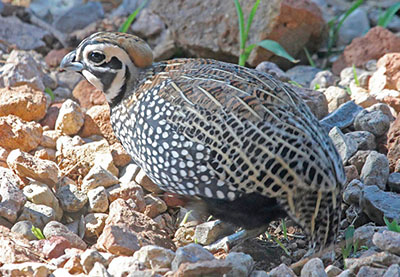Guide L-303
Revised by Sam Smallidge
College of Agricultural, Consumer and Environmental Sciences, New Mexico State University
Author: Extension Wildlife Specialist, Department of Extension Animal Sciences and Natural Resources, New Mexico State University. (Print Friendly PDF)
Habitat
Mearn’s quail (Cyrtonyx montezumae), also called Montezuma quail, are found in dense grass cover in mountainous parts of south-central and southwestern New Mexico. They are generally associated with pine-oak woodlands above 4,000 feet in elevation. Habitat is associated with moderate slopes of 20–30% and rock outcrops. They may be observed in lesser numbers on lower elevation mesquite grasslands and higher elevation pine and fir forest types. These elusive birds are often first noted when they explode suddenly in a frenzy of vibrating wings at close proximity. When Mearn’s quail are present, they are often more abundant than people think because they tend to live in heavy cover and hide rather than run or fly as other quail do. A person will need a good bird dog to census or hunt these quail.
Physical Description
Mearn’s quail are slightly smaller than other New Mexico quail, about 8–9 inches in height. They have short tails and large feet with arched claws. Male and female coloration differs. Males have bold white and black facial markings, a tan crest, a dark chestnut breast, and dark gray sides and flanks with prominent white spots (Figure 1). Females lack the bold facial markings and are brown with white, black, and brown mottling. Their coloration provides excellent camouflage in the areas they inhabit.

Figure 1. Male Mearn’s quail. (© Jerry Oldnettel | Flickr.com)
Feeding Habits
Their feeding habits differ from other quail, which generally feed on seeds and forbs. Studies show Mearn’s quail prefer underground bulbs and tubers of wood sorrels (genus Oxalis), wild onions (genus Allium), and nutsedges (genus Cyperus). Their use of acorns, insects, grasses, and forbs varies depending on season. The small holes and cone-shaped excavations they make while digging for bulbs and tubers help identify their feeding areas. Diggings are about 2 inches long, 1 inch wide, and 2–3 inches deep. Free water does not seem to be necessary for them to survive and reproduce.
Factors Affecting Population
Drought and regular heavy grazing are believed to be the factors most detrimental to Mearn’s quail populations. Drought is harmful because the bird’s preferred plants grow in areas that tend to be more moist than surrounding areas. Heavy grazing removes the dense grass cover these birds hide in and may eliminate plants that produce their preferred foods.
This species nests later than other New Mexico quails, from early June through late September; therefore, Mearn’s quail populations may benefit from a grazing system that rotates livestock out of areas where quail concentrate during nesting time. Observed population densities are similar in moderately grazed (up to 50% use) and ungrazed areas. However, light to conservative grazing (up to 40% use) may be more compatible for promoting habitat. Continued heavy grazing (greater than 50%) may eliminate local populations. In times of drought, impacts of heavy grazing would be more pronounced.
Severe and prolonged winter storms also cause population declines. Heavy snow and frozen ground prevent them from digging for food. Under these conditions, Mearn’s quail rely on seed-retaining trees and large shrubs for emergency food.
As with other quail, nesting success for Mearn’s quail varies greatly and influences annual population abundance. Spring and summer moisture has a strong influence on reproduction and chick survival. Although sufficient moisture is necessary for hatching, heavy rains shortly after hatching may lead to high chick mortality.
Management Recommendations
Management information for Mearn’s quail is limited. Generally, management that would benefit other quail species should benefit Mearn’s quail. Light to conservative stocking rates or deferring grazing in Mearn’s quail habitat during the growing season may be beneficial. Build fenced enclosures to enhance nesting and hiding cover. Prescribed fire may also be beneficial if post-fire vegetation response is good, although a temporary reduction in quail numbers may be expected. Planting or promoting preferred foods such as nutsedges, wild onions, and wood sorrels may help attract and hold quail. Many of these practices have not been adequately tested to determine their value for managing Mearn’s quail habitat.
Mearn’s quail are a difficult species to manage. Even when quality habitat is maintained, uncontrollable factors may suppress population abundance. Likewise, winter populations may appear low, but a good nesting season and high chick survival will result in an abundant fall population.
For Further Reading
L-112: Guide to Coaching a National 4-H and FFA Wildlife Habitat Education Program Team
pubs.nmsu.edu/_l/L112/
L-304: Scaled Quail Habitat Management
pubs.nmsu.edu/_l/L304/
CR-605: Establishing a Shooting Preserve as a Means of Diversification for Landowners in New Mexico
pubs.nmsu.edu/_circulars/CR605/
Original authors: Charles Dixon and Jim Knight, Extension Wildlife Specialists.

Sam T. Smallidge is the Extension Wildlife Specialist at New Mexico State University. He has degrees in wildlife and range management. His Extension program focuses on wildlife damage management, wildlife enterprises, and wildlife ecology and management education for youth and adults.
To find more resources for your business, home, or family, visit the College of Agricultural, Consumer and Environmental Sciences on the World Wide Web at pubs.nmsu.edu.
Contents of publications may be freely reproduced, with an appropriate citation, for educational purposes. All other rights reserved. For permission to use publications for other purposes, contact pubs@nmsu.edu or the authors listed on the publication.
New Mexico State University is an equal opportunity/affirmative action employer and educator. NMSU and the U.S. Department of Agriculture cooperating.
Revised May 2020 Las Cruces, NM


